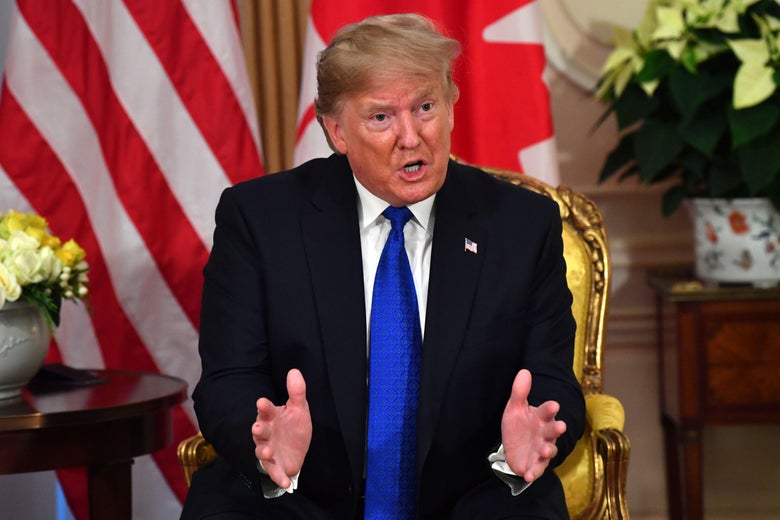
Donald Trump during a meeting at Winfield House, London on December 3, 2019.
NICHOLAS KAMM/Getty Images
For a hot second, it seemed as if Donald Trump might finally be interested in easing up on his global trade war. In October, he surprised the world and gave markets a lift by announcing that the U.S. and China were ironing out a “phase one” agreement that could forestall another round of tariffs between the two countries. Negotiators from both sides have been talking since, and by last week, stocks hit new highs thanks to optimism over a potential deal.
So much for good vibes. This week, the president decided to remind the world that he is, in fact, “a Tariff Man,” by announcing a series of aggressive moves aimed at punishing various U.S. trade partners for slights, both real and perceived, while telling journalists that a full agreement between Washington and Beijing might not happen until after the 2020 election.
The fun started early Monday morning, when Trump tweeted that he would slap tariffs on steel and aluminum from Brazil and Argentina for allowing their currencies to devalue. Both countries had previously been granted exemptions from the worldwide tariffs on metal imports the White House erected in 2018.
The move was unexpected. Brazil’s far-right president, Jair Bolsonaro, who is personally friendly with Trump, seemed to have no idea it was coming. It was also bizarre. Ordinarily, politicians get angry when their trade partners purposely manipulate the value of their currency to give their exports an unfair advantage. But neither Argentina nor Brazil have been doing any such thing. Their currencies have fallen against the dollar because their economies are simply a wreck. Argentina is reeling through yet another full-blown financial crisis, while Brazil is barely growing and mired in high unemployment. For various reasons, both countries have actually taken steps to push their currency back up against the dollar recently. Their governments aren’t “presiding over massive devaluations.” They are trying frantically to stop them.
But there’s an additional, subtle layer of absurdity to the situation. Our president is purportedly mad because he thinks American farmers are being undercut on price by competitors from Brazil and Argentina, who benefit from a cheaper currency. (In reality, they’re losing business to Latin America in large part because of Trump’s trade war with China, but let’s not digress.) However, if Trump follows through on his new threat, it is likely that Brazil and Argentina’s currencies will fall even further, since the tariffs will hurt their steel and aluminum exports. (After Trump’s tweet, Brazil’s real immediately dropped half a percentage point.) This, in turn, would make life even more unpleasant for American farmers. The whole thing is nonsensical and counterproductive. Or, in a word, Trumpian.
Monday also brought news that the U.S. was ratcheting up its trade hostilities with—le sigh— France. In a new report, the Office of the U.S. Trade Representative concluded that France’s new “digital services tax” on large internet companies essentially discriminated against U.S. tech firms like Google and Facebook. It then proposed retaliating with tariffs as high as 100 percent on French products such as wine and cheese. The new duties won’t be implemented at least until January, but they would fall on top of the 25 percent tariffs the administration announced in October as part of a long-running dispute with the European Union over subsidies for aircraft manufacturers. Now might be a good time to stock up on Bordeaux, if that’s your thing.
Unlike Trump’s outburst at Brazil and Argentina, the administration’s threats against the French are part of a fairly normal, if complicated, international dispute. Several European countries have proposed or introduced levies on large, multi-national tech companies, such as Google, that currently tend to pay very little tax in the countries where they operate thanks to their creative accounting. France passed its own version last year, prompting the U.S. to open its investigation into trade discrimination. The Trump administration is now threatening that it might throw up similar tariffs against other countries with digital services taxes, such as Austria, Italy and Turkey. The White House is essentially making a show of force on behalf of U.S. internet giants—a show of force that could doom efforts by the Organization for Economic Co-operation and Development to negotiate a global treaty on digital taxes that would avoid a patchwork of national laws and tit-for-tat trade battles. The administration is once again choosing to throw its weight around rather than work within any kind of international order.
Trump completed his chaotic little trade hat trick on Tuesday while in London for the NATO conference, where he cast doubt on the possibility that the U.S. and China would soon reach a trade agreement. “I have no deadline,” he told reporters. “In some ways I like the idea of waiting until after the election for the China deal.” Just to confuse things more, he then suggested an agreement could still be imminent. “But they want to make a deal now, and we’ll see whether or not the deal’s going to be right, it’s got to be right.” Either way, investors, who had high hopes that China and the U.S. were close to a detente, were unhappy; stocks dropped for the third straight day.
Trump’s comments, as usual, are a bit difficult to interpret. Maybe there won’t be a deal for a while, he says, or maybe there will. He seems to be lowering expectations for an agreement, and trying to signal that he isn’t worried that a trade war will hurt his re-election chances. It could be a very public bluff. Or it could be Trump returning to his old, combative yet ineffective ways on trade.
Readers like you make our work possible. Help us continue to provide the reporting, commentary and criticism you won’t find anywhere else.
Join Slate Plusfrom Slate Magazine https://ift.tt/33NgVea
via IFTTT
沒有留言:
張貼留言